Related Research Articles

Fielding Harris Yost was an American college football player, coach and athletics administrator. He served as the head football coach at: Ohio Wesleyan University, the University of Nebraska, the University of Kansas, Stanford University, San Jose State University, and the University of Michigan, compiling a coaching career record of 198–35–12. During his 25 seasons as the head football coach at Ann Arbor, Yost's Michigan Wolverines won six national championships, captured ten Big Ten Conference titles, and amassed a record of 165–29–10.

Joseph Napoleon "Big Chief" Guyon was an American Indian from the Ojibwa tribe (Chippewa) who was an American football and baseball player and coach. He played college football at the Carlisle Indian Industrial School from 1912 to 1913 and Georgia Tech from 1917 to 1918 and with a number of professional clubs from 1919 to 1927. He was inducted into the Pro Football Hall of Fame in 1966 and the College Football Hall of Fame in 1971.

Earl C. "Tuffy" Abell was an American college football player and coach. He played football as a tackle at Colgate University. He later returned to Colgate as an assistant coach in 1925, and took over the head coaching job in 1928. He spent the 1929 and 1930 football seasons as head football coach at the University of Virginia. Abell was inducted into the College Football Hall of Fame as player in 1973.

George Edkin Little was an American football player, and coach of football, basketball, and baseball, and college athletics administrator.

Frederick Mitchell Walker, nicknamed "Mysterious", was an American athlete and coach. He was a three-sport athlete for the University of Chicago from 1904 to 1906 and played Major League Baseball as a right-handed pitcher for the Cincinnati Reds, Cleveland Indians, Brooklyn Superbas, Pittsburgh Rebels and Brooklyn Tip-Tops.

Edwin Regur Sweetland was an American coach, trainer, and athletic administrator at several universities. During his coaching career he was head coach of many sports including basketball, track and field, and rowing, but the majority of for his coaching work was in football. Though mainly known for football, he left his mark on several college athletics departments and other sports. This includes being the first athletic trainer at Ohio State University, the first paid coach of the Kentucky Wildcats men's basketball team, and the first coach of Syracuse University rowing team.

Guy Sumner Lowman was an American football, basketball, and baseball coach and a player of baseball. He served as the head football coach at Warrensburg Teachers College—now the University of Central Missouri (1907), the University of Alabama (1910), Kansas State University (1911–1914), and the University of Wisconsin–Madison (1918). Lowman also coached basketball at Warrensburg Teachers College, now known as the University of Central Missouri (1907–1908), the University of Missouri, (1908–1910), Kansas State (1911–1914), Indiana University (1916), and Wisconsin (1917–1920) and baseball at Central Missouri State (1907–1908), Missouri (1909–1910), Alabama (1911), Kansas State (1912–1915), and Wisconsin.

William J. Juneau was an American football player and coach of football, basketball, and baseball. He served as the head football coach at Colorado College (1904), South Dakota State College of Agricultural and Mechanic Arts (1906–1907), Marquette University (1908–1911), the University of Wisconsin–Madison (1912–1915), the University of Texas at Austin (1917–1919), and the University of Kentucky (1920–1922), compiling a career college football record of 86–39–10. Juneau was also the head basketball coach at South Dakota State for two seasons from 1905 to 1907, tallying a mark of 7–5. He coached baseball at South Dakota State in 1906 and 1908 and at Wisconsin in 1913, amassing a career college baseball record of 15–12–1.
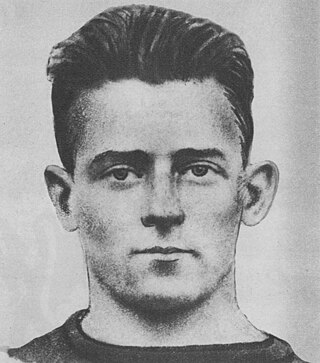
Charles Emile "Gus" Dorais was an American football player, coach, and athletic administrator.

Harold Roy Ballin was an American football player and coach. He played at the tackle position for Princeton University from 1912 to 1914 and was a consensus first-team All-American in both 1913 and 1914. Ballin served as the head football coach at Duquesne University from 1922 to 1923, compiling a record of 4–12. He was inducted into the College Football Hall of Fame as a player in 1973.

Glen Carlton Gray was an American football and basketball player and coach. He served as the head football coach at Oberlin College from 1911 to 1912 and at Washburn University from 1913 to 1915, compiling a career college football coaching record of 23–13–4. Gray was also the head basketball coach at Oberlin in 1910–11 and 1912–13, tallying a mark of 17–7.
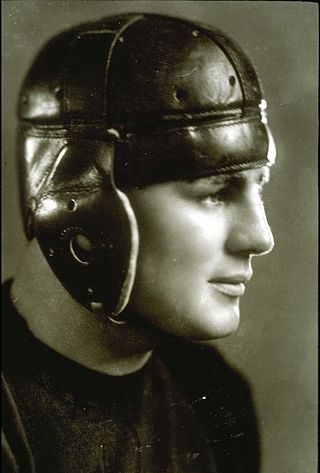
Edward Ratliff "Butch" Slaughter Sr., also known as Edliff Slaughter, was an American football player, athletic coach and professor of physical education. He played guard at the University of Michigan from 1922 to 1924, and was chosen as a first-team All-American in 1924. Slaughter served as an assistant football coach at the University of Wisconsin, North Carolina State University, and the University of Virginia. He was also a member of the faculty at the University of Virginia, and held a variety of positions, including Chairman of the Department of Physical Education and Director of Intramural Sports, from 1931 until his retirement in 1973.

William Philip Edmunds was an American football player, coach of football and basketball, college athletics administrator, and medical doctor. He played college football at the University of Michigan from 1908 to 1910. He was the head football coach at West Virginia University (1912), Washington University in St. Louis (1913–1916), and the University of Vermont (1919), compiling a career college football coach record of 19–22–2. Edmunds was also the head basketball coach at Washington University for on season in 1913–14, tallying a mark of 7–6.
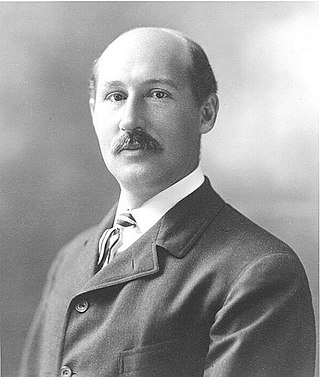
The 1912 College Football All-America team is composed of college football players who were selected as All-Americans for the 1912 college football season. The only selector for the 1912 season who has been recognized as "official" by the National Collegiate Athletic Association (NCAA) is Walter Camp. Many other sports writers, newspapers, coaches and others also selected All-America teams in 1912. One writer, Louis A. Dougher, published a "Composite Eleven" in the Washington Times which consisted of his aggregating the first-team picks of 23 selectors.

The 1913 College Football All-America team is composed of college football players who were selected as All-Americans for the 1913 college football season. The only two selectors who have been recognized as "official" selectors by the National Collegiate Athletic Association (NCAA) for the 1913 season are Walter Camp and the International News Service (INS). Camp's All-America Team was published in Collier's Weekly. The INS was founded in 1909 by William Randolph Hearst, and its sports editor Frank G. Menke selected the INS All-America team. Other sports writers, newspapers, coaches selecting All-America teams in 1913 included Harper's Weekly, Fielding H. Yost, and Parke H. Davis.

The 1913 Michigan Wolverines football team represented the University of Michigan in the 1913 college football season. The season was Fielding H. Yost's 13th as Michigan's head football coach. The team compiled a record of 6–1, outscored opponents 175 to 21, and shut out four opponents while giving up an average of only three points per game.
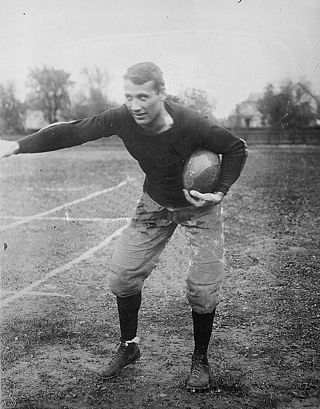
Alfred Leo Buser, nicknamed Al Buser, was an American football player and coach. Buser played college football for the University of Wisconsin, and was recognized as an All-American. He later became the fourth head coach of the Florida Gators football team that represents the University of Florida.
Danny Hutchinson was an American college football player and coach. He played football for the University of Pennsylvania in 1908 and 1909 and served as the head football coach at Wesleyan University in 1913.
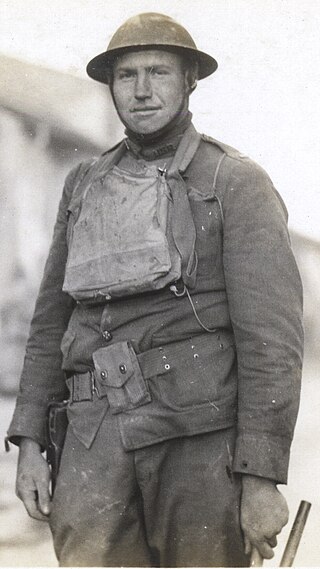
Joseph W. Brooks was an American football player and coach. He played for Williams College and Colgate University from 1909 to 1914. He was the head football coach at Williams College in 1916, 1919 and 1920.

Morris S. Halliday was a lawyer and politician who represented the forty-first Senate District in the State of New York Senate from 1915 to 1918. He was also a noted football player at Cornell University during the early 20th century. In 1906, he served as the head coach at Hamilton College, compiling a record of 1–5–2. In later life, Halliday was involved in property management in Cleveland, Ohio.
References
- 1 2 Freitag, Duane H. (2012), Sauerkraut, Suspenders, and the Swiss: A Political History of Green County's Swiss Colony 1845-1945, Bloomington, Indiana: iUniverse, pp. 247–258, ISBN 978-1-4759-0750-6
- ↑ "2012 Wisconsin Football Fact Book" (PDF). University of Wisconsin. Archived from the original (PDF) on December 14, 2013. Retrieved December 13, 2013.
- 1 2 3 4 "Samp to Coach Williams", New York Times, September 25, 1918
- ↑ "Wisconsin Graduate Coach" (PDF), Geneva Daily Times, p. 6, April 2, 1913
- ↑ "Football: History: Coaching Record". Hamilton College. Retrieved December 23, 2010.
- ↑ Freitag p. 251
- ↑ "Edward J. Samp, Former State Securities Chief, Dies". The Capital Times . December 21, 1967. p. 29. Retrieved March 15, 2023.